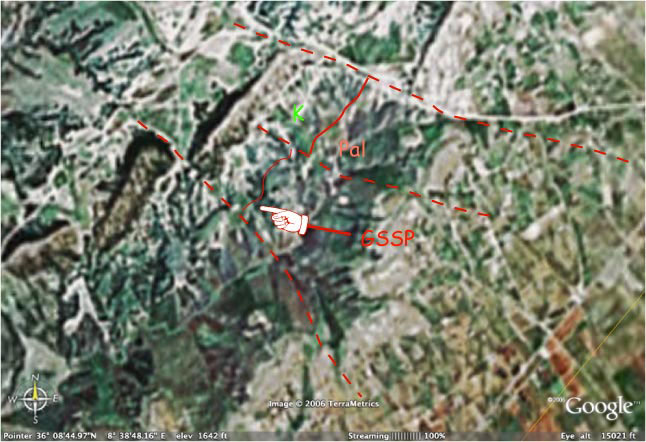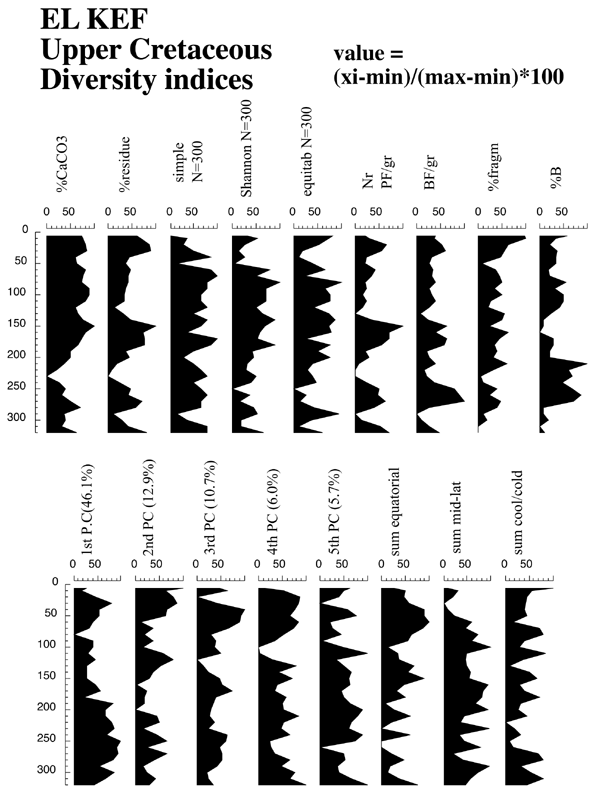 |
| Figure 1 geological sketchmap of the el Haria region |
The K/T boundary at El Kef, Tunisia
(published in: Ginsburg, R. N. (1997). "An attempt to resolve the controversy over the end-Cretaceous extinction of planktic foraminifera using a blind test. Introduction: background and procedures." Marine Micropaleontology 29: 67-68.
| R. Ginsburg, J. Smit, G. Keller, F. Zargouni, S. Razgallah, M. Shimi, O. Ben Abdelkader, N. Ben Haj Ali and H. Ben Salem. |
 |
| Google earth image of the K/Pg GSSP near El Kef. Move mouse across image for view of the geological interpretation. |
The sections sampled are located at El Haria, 5 km SW of El Kef in Northwestern Tunisia, a valley around the upper streams and tributaries of the Oued Djerfane (Fig 1). The more than 450 m (Fig 2) thick marl formation containing the KT boundary therefore bears its name (El Haria Formation). The KT boundary strikes roughly NE-SW (Fig 1), and crops out in several tributaries of the Oued Djerfane. Salaj, J., (1980), and Donze (1979), and members of a fieldtrip of the 3rd. (1973) African micropaleontological colloquium have collected samples at the KD locality (fig 1). These samples have been described in the earlier literature (e.g. Perch-Nielsen, K. et al., (1982); Donze, J. et al., (1982). Smit resampled the section in 1981, but found that the KT boundary at the KD locality was disturbed by smaller faults, branching from the main E-W striking fault (F1). The relatively reduced thickness of the "G." eugubina Zone (5-25 cm) at the KD locality as described by Salaj (1980) must be due to this faulting. For this reason, Smit decided to sample the KT boundary section in a deeper incised tributary, near the KS locality (fig 1), where the marls are relatively fresh and the section undisturbed through the El Haria Formation, although some faults occur (F2, fig. 1). In 1982 the KS section was resampled by a crew from the K/Pg boundary working group, in search for a suitable KT boundary Global Stratotype Section and Point (GSSP) candidate locality. The top 5m of the Maastrichtian and the entire Paleocene were sampled (the AFN sample set; fig1, section 4(AFN); fig 2, AFN (section 4). The AFN sample set was distributed among various scientists resulting in several publications (Brinkhuis, H. and Zachariasse, W.J., 1988; Keller, G., 1988a; Keller, G., 1988b; Keller, G. and Lindinger, M., 1989; Smit, J., 1982; Lindinger, M., 1989) leading to the present controversy. The K/Pg working group proposed the Kef section, more specifically the KS locality (fig. 1) as the GSSP for the K/Pg boundary, which was later ratified by IUGS (Cowie, J.W. et al., 1989). The composite complete section through the El Haria Fm. is shown in fig 2. To avoid a NE-SW trending fault (fig 1:F2), the Maastrichtian part of the Haria Fm. was measured in the three partial sections (sections 1-3, figs.1, 2). The El Haria Fm consists of hemipelagic brown-grey marls, containing 30-60% CaCO3, without clearly visible bedding-planes. The shales are rich in planktic foraminifera, except for the top 100 m of the Paleocene, where benthic foraminifers dominate. Three about 5m thick intervals occur (fig. 2), in which about 30 cm thick, whitish micritic limestone layers rhythmically alternate with darker marl layers.
Preceding the actual sampling of the blind samples, an International workshop on Cretaceous-Tertiary transitions was organized in Tunis, under the auspices of the GSGP, the Association Tunisienne des Etudes Internationales de Geologie and the Service Geologique de Tunisie. The conference was organized by F. Zargouni, S. Razgallah, M. Shimi, O. Ben Abdelkader, N. Ben Haj Ali and Habib Ben Salem. The staff of the Service Geologique National prepared the sections (KD and KS) for sampling. Trenches were dug at both the KS and KD localities, about 1m deep and wide, from 3m below to 8m above the K/T boundary. The KS trench (from which the coded samples for the blind test were chosen) parallels the base of the AFN section about 5m to the west.
60 samples were taken by the staff of the Service Geologique National. Samples were taken at 25 cm intervals from 3m below to 8.5 m above the K/T boundary, and at 5 cm intervals from 50cm below to 55cm above the K/T boundary (Fig 3). Each sample represents a stratigraphic thickness of about 5cm (Fig 3). Adhering dust was removed, and the samples bagged and labelled, and a portion sent to R. Ginsburg (Miami). Six samples (see fig 3 for codes and position) were chosen for the blind test.
References
Brinkhuis, H. and Zachariasse, W.J., 1988. Dinoflagellate cysts, sea level changes and planktonic foraminifers across the Cretaceous-Tertiary boundary at El Haria, northwest Tunisia. Marine Micropaleontology, 13: 153-191.
Cowie, J.W., Zieger, W., and Remane, J., 1989. Stratigraphic Commission accelerates progress, 1984-1989. Episodes, 112: 79-83.
Donze, J., Colin, J.P., Damotte, R., Oertli, H.J., Peypouquet, J.-P., and Said, R., 1982. Les Ostracodes du Campanien terminal a L'Eocene inferieur de la coupe du Kef, Tunesie Nord-orientale. Bull. Centr. Rech. Explor.-prod. Elf-Aquitaine, 6: 307-335.
Donze, P., 1979. "La Piste Du Hamman Mellegue" au SW du kef en Tunisie. In: Christensen, W.K. and Birkelund, T. (Christensen, W.K. and Birkelund, T.s), Cretaceous-Tertiary Boundary Events Symposium; II. Proceedings. Copenhagen, p. 237.
Keller, G., 1988a. Biotic turnover in benthic foraminifera across the Cretaceous/Tertiary boundary at El Kef, Tunisia. Palaeogeography, Palaeoclimatology, Palaeoecology, 66: 153-171.
Keller, G., 1988b. Extinction, survivorship and evolution of planktic Foraminifera across the Cretaceous/Tertiary boundary at El Kef, Tunisia. Marine Micropaleontology, 13: 239-263.
Keller, G. and Lindinger, M., 1989. Stable isotope, TOC, and CaCO3 record across the Cretaceous Tertiary boundary at El Kef, Tunisia. Paleogeogr. Paleoclimat, Paleoecol., 73: 243-265.
Lindinger, M., 1989. The Cretaceous Tertiary boundary in the Caravaca and Kef sections. PhD, ETH Zurich, pp. 230
Perch-Nielsen, K., McKenzie, J., and He, Q., 1982. Biostratigraphy and isotope stratigraphy and the 'catastrophic' extinction of calcareous nannoplankton at the Cretaceous/Tertiary boundary. Geol. Soc. Am. Special Paper, 190: 353-371.
Salaj, J., 1980. Microbiostratigraphie du Cretace et du Paleogene de la Tunesie septentrionale et orientale. Geologicky Ustav Dionysza Stura, Bratislava, pp. 238.
Smit, J., 1982. Extinction and evolution of planktonic foraminifera after a major impact at the Cretaceous/Tertiary boundary. Geol. Soc. Am. Special Paper, 190: 329-352.
|
|
 |
||
Relative abundance of Maastrichtian foraminifers in
top 3.2 m. of the Maastrichtian of the Kef section (K/Pg gssp section
see fig 1). 0 level is the K/Pg boundary. Samples were taken every
10cm true vertical stratigraphic distance.
|
(Hi res image) | Upper row: CaCO3 (%), weight % residue>40micron,
diversity indices of foraminiferal relative abundances, PF/gr = number
of planktic forams/gram dry sediment, BF/gr = (benthic foram/gr dry sed.),
% fragments, %B = % benthics |
(Hi Res image) |
|
|
Figure 3. (back to top) Detailed interval of the KS section around the K/T boundary sampled for the blind test. Position of the analysed (coded- 3710-3809) samples is indicated as well as the stratigraphic thickness of each sample. |
Figure 2. (back to top) Stratigraphic columns through the entire Haria Fm at El Kef. The Maastrichtian part is composed of three partial sections (1-3, c.f. fig. 1) because fault F2 prevents measurement in one continuous section. The AFN section (4) was sampled in 1982 and has served as reference section for the K/Pg working group. The present controversy concerns interpretations of this sample set. (see text). |